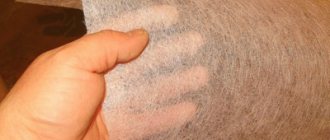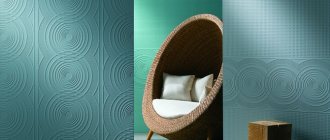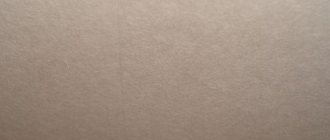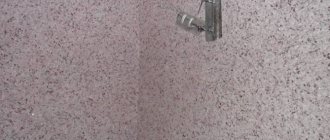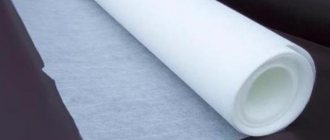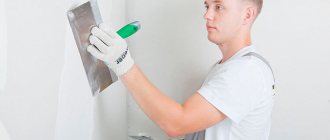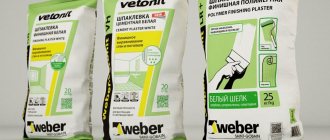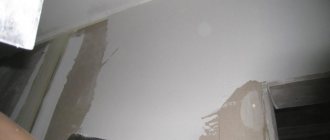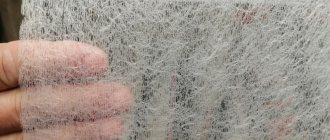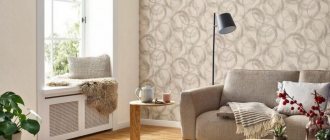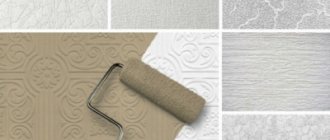10/14/2018 Painting walls is one of the most effective and simple methods of interior decoration. Modern paints allow you to give the room an aesthetic appearance, make it rich and beautiful. Painted walls, unlike wallpaper, look monolithic and have no seams. Finished surfaces are easy to clean, do not absorb odors, provide a long service life and allow you to update the interior with a simple repainting.
Before carrying out this kind of repair, the walls must be prepared. If the old plaster is weak, or there are significant defects on the surface in the form of broken areas or large irregularities, then preliminary plastering is indispensable. But when it comes to relatively smooth walls or ceilings with minor defects, you can get by with less labor-intensive preparation. For this purpose, special types of rolled covering materials are used: glass wallpaper or paintable wallpaper on a non-woven basis. For many, choosing one material or another can be difficult. Which is better? Let’s try to figure it out in this article.
Working with wallpaper
Wallpaper is produced in several categories based on the material of production:
Working with non-woven and glass wallpaper gives a double effect:
- A perfectly smooth wall surface; when painted, defects from the wall surface do not appear on it.
- The walls receive a protective and reinforcing coating, guaranteeing cracks or breaks in the future.
Advice. This is especially important in high-rise apartments, where the seams between the walls are constantly growing. They are simply not visible under the glass wallpaper. Working with glass wallpaper has similar characteristics.
Fiberglass wallpaper is a woven fabric made of glass fibers
Threads are drawn from liquid glass and woven into cloth.
There are two types of glass wallpaper:
The difference between them is only in technology and type of weaving:
- In the first case, the material is similar to ordinary smooth canvas,
- In the second, they are decorated with a certain relief pattern, moreover, they are characterized by greater density than the first.
- Fiberglass is used to strengthen walls and smooth their surfaces.
Note. This procedure is especially often performed in the finishing of ceilings. Here it is easier to glue fiberglass onto its surface than to carry out plastering and putty work.
- The surfaces are perfectly smooth, with a texture reminiscent of marble.
- But they can only look like this if they are painted, and not covered with other wallpaper.
Advantages of glass wallpaper, comparison with non-woven wallpaper
The material is sold in rolls and consists of fiberglass impregnated with a special substance and a backing.
The front side has a clearly defined texture and is intended for further coloring:
- Non-woven wallpaper is considered a good competitor for them in terms of painting.
- A composite paper-like type of finishing material consisting of cellulose and binder in proportions of 70% and 30%, respectively.
Note. Unlike the material in question, the material is pressed rather than woven. Available in the form of non-woven fabric.
Advantages and disadvantages of both types of paintings:
| Glass wallpaper | Non-woven fabric |
| Eco-friendly, completely harmless to humans. | High degree of strength. |
| Resistant to temperature changes, waterproof. | Abrasion resistance. |
| They allow steam and air to pass through. | Fire resistant. |
| Resistant to aggressive detergents. | The adhesive composition is applied to the base of the wall, and not to the canvas. |
| The degree of strength and durability is high. | Does not shrink after drying. |
| Electrostatic | Having a dense base, they hide minor imperfections on the walls or ceiling |
| Easy to care for. | Lets air through. |
| They can be painted multiple times without losing their appearance. | They are washed with special means and belong to the category of washing coatings. |
| Fire resistant because they do not support combustion. | They don't fade, they stick easily. |
Disadvantages of fiberglass and non-woven wallpaper:
| Glass wallpaper | Non-woven |
| High price of material | When using a fabric with a very voluminous texture, dust collects on it. Remove with a vacuum cleaner or dry cloth; do not get them wet. |
| The adhesive composition used is only that intended for liquid wallpaper. | Low resistance to repeated mechanical damage |
| To dismantle the coating you will need a special liquid | The price of the paintings is very high |
Interesting fact! Non-woven wallpaper, in general, is less durable, more susceptible to abrasion, and is less resistant to accidental mechanical damage, unlike glass wallpaper. For this reason, they are not recommended for use in public spaces.
Non-woven fabrics are considered heavy, and they are prone to moisture absorption. For example, due to normal wetness or glue, so the composition cannot be applied to the canvas. The answer to the question: whether to choose non-woven or glass wallpaper is individual for everyone and depends on one’s own preferences and wishes.
When which material is better?
It is better to choose the material for decorating walls according to several parameters:
- Wall quality . Non-woven finishing material can hide quite serious defects on the walls, and fiberglass is best glued to a flat surface.
- Terms of Use. It is better to glue interlining in dry rooms - living rooms, bedrooms. With high humidity, the canvas deteriorates, moves in waves, and peels off the wall. Fiberglass wallpaper has a wider range of applications due to its resistance to moisture and various mechanical stress. Therefore, they can be glued in the hallway, kitchen and even bathroom.
- Aesthetics . Fiberglass wallpaper is significantly inferior to the non-woven version in terms of breadth of assortment.
- Place of gluing . Fiberglass fabric is heavy and dense, so it is mainly used on walls. Non-woven fabric is softer and less dense; it can be used even on problematic, complex surfaces - ceilings, walls at different angles, frames with arches.
The choice between non-woven or glass wallpaper depends on personal aesthetic preferences, as well as the place of use and purpose of application. Knowing all the pros and cons of each material will help you make the right choice.
Repair and constructionComment
Where are glass fibers used?
In addition to direct use (as wallpaper), they can be used for:
- Decoration of facade parts.
- Furniture.
- Doors.
- And other surfaces.
The material is not only good and beautiful in terms of finishing, but is also very famous for its practicality:
- It is not afraid of frequent wet cleaning, even with disinfectants in public buildings, in particular hospitals.
- In private houses and apartments, this material is also popular and not only for finishing the surfaces of walls or ceilings, in bathrooms they can replace ceramic tiles (see: Ceramic tiling of a bathroom: a classic of the genre).
- Thanks to its unique properties and texture of the canvas, glass wallpaper gives an appearance unique in style and beauty.
The only condition is the correct selection of colors and tones. The correct gluing instructions and finishing options are presented in the video in this article.
What adhesive to use for gluing fiberglass?
If we consider the composition of the glue specifically for this category of wallpaper, then it is made on the basis of starch, with various additives that improve the moisture-resistant qualities of the canvases and antibacterial properties.
Let's look at which adhesive is best for glass wallpaper, and what it comes in:
- In fact, the more expensive the composition, the faster it swells and has better adhesive properties.
- And since glass fibers are much heavier than their paper counterparts, the choice should be made in favor of those that can better hold them on the surface.
Advice. It is better to choose types based on PVA glue or dispersion, they are designed for heavy canvases.
| 1. | Dry mixes. | Most of the adhesive compositions for this material are produced in powder form from adhesive components with antiseptic additives. It has a low specific gravity and is stored for a long time without losing its qualities. |
| 2. | Ready-made adhesive solutions. | This is a completely ready-to-use composition consisting of adhesives and various additives. It goes on sale packaged in containers (plastic buckets) of 5 kg and 10 kg. Shelf life depends on the manufacturer; it can withstand about 5 cycles (freezing/thawing) without losing its quality properties. |
Wallpaper paint
The main criteria when choosing paint for wallpaper are its resistance to mechanical stress and moisture, the time required for drying, and also environmental friendliness. If we talk about interior decoration, then interior paints are used, which can be water-dispersion and alkyd.
Water-dispersion paints are made on a water basis. They use emulsion and latex as additional components. Such paints dry quickly and have no odors, are environmentally friendly and do not contain harmful substances. Wallpaper painted with water-dispersion paint has protection in the form of a film from minor mechanical damage, and is also able to allow air to pass through normally. Paints of this type can be water-based and latex, as well as acrylic (latex-based acrylic).
When using latex paint, the structure of the wallpaper is strengthened and can be washed more often.
Alkyd paints are suitable for fiberglass wallpaper. Thanks to this paint, a protective layer is formed on the surface of the wallpaper, which allows you to safely wash it using chemicals.
However, this type of paint has its drawbacks. Alkyd paints contain toxic substances, and such paints do not allow air to pass through. For these reasons, it is not recommended to paint walls with similar paints in residential areas.
Source
The difference between fiberglass and glass wallpaper
Fiberglass, otherwise known as painter's web, is a building material created from natural ingredients, sand and natural resins. Fiberglass is produced by heating special glass and then drawing fibers from the glass, which are arranged in a chaotic manner, dried and the finished material is obtained. The manufacturing process is similar to the production of fiberglass wallpaper, however, there are significant differences in the production and use of finishing materials. The differences between fiberglass and glass wallpaper include:
- Creating glass wallpaper is weaving from heated glass fibers; the arrangement of threads in the fiberglass is chaotic, without patterns or designs. Fiberglass is produced by pressing, which reduces time costs.
- Fiberglass is a relief decorative finishing material, fiberglass is an element of the final or intermediate finishing of a wall or ceiling in order to strengthen the surface. Fiberglass is absolutely smooth, which allows it to be used as a preliminary preparation of the surface for further finishing.
In conclusion
The choice remains with everyone who plans to use these coatings in apartment renovation. Regardless of the choice, the appearance of the room after renovation will look original, stylish and aesthetically pleasing in any case. If the decor often gets boring, and the desire to change the design is irresistible, then it is best to glue glass wallpaper; they can be repainted at least annually in any shade.
Source
Various materials are used to reinforce wall and ceiling bases, and often before starting interior decoration, the question arises: “What should I buy? Fiberglass or Non-woven fabric?”
Let's objectively analyze the features of the application and, most importantly, look at the results of working with popular building materials for leveling the base of walls and ceilings. Which material, Vitrulan VPP200 fiberglass or repair non-woven fabric, can replace finishing putty and be guaranteed to provide an absolutely seamless surface?
Nonwoven
Fiberglass
Painting fiberglass is a colleague of non-woven fabric in the workshop, but the material differs in composition, production method and physical and mechanical properties.
German Fiberglass VPP 200 SX-JV has a high density of 200 g/m2 - it is a modern environmentally friendly finishing material containing mineral materials of natural origin. During the melting process, threads are obtained from quartz sand, which are randomly layered on top of each other and glued together to form a smooth fabric, which at the next stage of production is covered with high-quality white primer. Preliminary priming ensures uniform distribution of paint on the surface of the canvas and significantly reduces the consumption of paints and varnishes.
Advantages of using fiberglass
The use of fiberglass is justified in many cases of construction or repair:
- Shrinkage of a newly constructed building. In this case, glue the fiberglass to the walls and ceiling, and the problem of cracks will not be a problem for the new renovation.
- Expansion and contraction of structural materials due to temperature. Fiberglass will extend the service life of the material for a long time.
- Roofing. Place fiberglass directly under the bitumen impregnation to strengthen the surface.
- Strengthening the walls of the room in which equipment with increased vibration is located during operation. Or the location of the house in close proximity to the railway.
- An additional layer when laying waterproofing and creating a drainage system in a summer cottage.
The advantages of fiberglass include:
- Environmentally friendly and natural composition, the use of fiberglass is allowed in any premises, medical institutions, apartments with children, allergy sufferers and animals.
- Safety, the material is not flammable and does not corrode.
- Antistatic, does not attract dust, debris, does not create static.
- Air permeability, thanks to the breathing properties of the base, the appearance of mold and fungi is not dangerous.
- Easy to maintain if fiberglass is chosen as the final finish. It won't take much time to quickly brush off the dust or wash the stained area.
- Durability, fiberglass will last longer than 30 years.
Features and advantages of non-woven canvas gluing technology
The process of installing non-woven fabric for painting is easy; you start by applying wallpaper glue to the base itself, then sheets of reinforcing material cut to the size of the surface are applied to the adhesive layer. On the surface, smoothing and distribution of the product occurs quickly and without problems. Therefore, a beginner can easily carry out the entire process without turning to a professional for services.
This technology for installing non-woven fabric helps reduce the consumption of adhesive solution. But first, the surface should be properly prepared so that it is free from flaws and smooth. The mixture is selected based on the condition of the surface.
The adhesive solution is prepared thick, the wall is carefully coated with it, the interlining itself should be mounted using a plumb line so as not to be mistaken in its evenness. The strips are glued end to end and pressed to secure them well.
If the strips are too long, then carefully cut the excess part with a sharp knife. When the drying period specified by the material manufacturer has passed for the adhesive solution, proceed to further finishing work.
On the surface, smoothing and distribution of the product occurs quickly and without problems.
Types of fiberglass
The material varies in density per 1 sq.m.; there are 3 main types of fiberglass. Density of fiberglass 25 g/sq.m. means that a square meter of material weighs only 25 grams. The optimal place to use such a fabric is the ceiling; fiberglass of this density is often called ceiling web. The advantage of the low weight of fiberglass is also its disadvantage - before use it is necessary to get rid of large cracks in the base, if any, on the surface. Cobweb with a density of 40 g/sq.m. – a universal option, used for reinforcing the walls of premises for further painting or wallpapering. This material is also suitable for strengthening the ceiling of old buildings or those located in a high vibration zone.
Fiberglass with a density of over 50 g/sq.m. used in industrial premises with high load on the walls from operating machines and equipment. A larger amount of material is used for production; gluing will require a lot of glue and paint, so this type of finish is not practical for use in residential premises.
Features and advantages of non-woven canvas gluing technology
The material is easy to stick to the surface to be treated. Wallpaper glue is applied directly to the wall, and after this treatment, painting non-woven fabrics are applied to the surface treated with glue in a dry form. The master can easily and with high accuracy adjust the strips relative to each other. When gluing non-woven canvas onto the surface of the walls, it can be easily smoothed and straightened, even if it was stored in a deformed form in a roll. This also facilitates and simplifies the task of the master and allows him to create the smoothest surface.
This technology for gluing the material guarantees economical consumption of rather expensive wallpaper glue. Not only money is saved, but also the technician’s time, and, consequently, the repair is completed faster.
Before gluing the canvas, it is necessary to properly treat the base. Depending on its type, this could be:
- putty,
- reinforcement of cracks, etc.
After processing and cleaning, the painting non-woven fabric is glued using a thick wallpaper compound. It is advisable to use Oscar glue. Sheets of painting non-woven fabric are placed plumb and end-to-end in a thick layer of glue, then pressed.
If excess appears at the joints of the floor, ceiling, window or door openings, they are cut off with a sharp knife. After a certain drying period, wallpaper is glued to the non-woven canvas, dispersion paint or other decorating material is applied.
By choosing high-quality and reliable painting non-woven fabric from such manufacturers, you can get a material that is practical and easy to work with. Market leaders such as Wellton, the Swedish Ahlstrom or the international concern John Manville offer nonwoven materials of guaranteed quality.
What is better to choose for painting: glass wallpaper or paper wallpaper
10/14/2018 Painting walls is one of the most effective and simple methods of interior decoration. Modern paints allow you to give the room an aesthetic appearance, make it rich and beautiful. Painted walls, unlike wallpaper, look monolithic and have no seams. Finished surfaces are easy to clean, do not absorb odors, provide a long service life and allow you to update the interior with a simple repainting.
Before carrying out this kind of repair, the walls must be prepared. If the old plaster is weak, or there are significant defects on the surface in the form of broken areas or large irregularities, then preliminary plastering is indispensable. But when it comes to relatively smooth walls or ceilings with minor defects, you can get by with less labor-intensive preparation. For this purpose, special types of rolled covering materials are used: glass wallpaper or paintable wallpaper on a non-woven basis. For many, choosing one material or another can be difficult. Which is better? Let’s try to figure it out in this article.
Features of non-woven coverings
Non-woven wallpaper is a non-woven covering made from textile fibers and cellulose. The binder is a substance whose characteristics resemble fiberglass. But unlike it, it has a finer structure. This is why fiberglass and non-woven fabric are so often compared.
Non-woven wallpaper for painting ceilings has the following advantages:
- Covering surfaces with wallpaper based on non-woven fabric is very simple due to the stability of the material. The product does not stretch when wet and does not shrink in size after drying.
- The coating does not tear, therefore, compared to paper, it is more durable.
- Wallpaper has high aesthetic characteristics. There are products on sale in different colors, with patterns and embossed surfaces.
- During the gluing process, the adjustment of the strips of material is carried out with high precision, because the glue is applied only to the base surface, and the panel is applied dry. This is especially convenient when gluing the ceiling.
- When carrying out repair work, you can remove only the top layer of wallpaper, and leave the non-woven base on the surface as a strengthening and leveling base.
- Gluing non-woven fabric to the ceiling is done on different types of bases - wood, concrete, plasterboard.
If you have a question about what is better, fiberglass or non-woven fabric for painting a ceiling, then the differences between these materials are as follows:
- Fiberglass wallpaper is very durable and resistant to mechanical damage, which cannot be said about the top layer of non-woven coating, which is easily damaged by furniture or animal claws.
- Any contamination can be washed off the surface of the fiberglass using household chemicals. Non-woven products should not be washed with detergents and should not be actively rubbed.
- Fiberglass reinforces the surface to be glued and does not require careful preparation of the base. Non-woven fabric requires surface leveling as it does not hide significant defects.
- Fiberglass allows the surface under the coating to “breathe” and protects against mold formation and damage by microorganisms.
- Fiberglass wallpaper will last up to 30 years and will withstand up to 20 paintings, which cannot be said about filiseline. Its service life reaches 15 years. The maximum number of colors that non-woven wallpaper can withstand is 5-7.
Fiberglass and its use
Despite the promising name, fiberglass in rolls is not at all as strong as glass; if handled carelessly, it can even be torn. However, if you glue it using technology, it will become real “armor” and will not allow cracks to spread. Available in rolls (width 1 m, length up to 50 meters), the density varies from 25 to 65 grams per square meter, but even the minimum density is enough for finishing the ceiling and walls.
The composition of fiberglass includes quartz sand, soda, dolomite, lime and chemical additives. The mixture heats up, forming threads that stick together and become like a spider's web.
Fiberglass mesh for painting
It is used for interior and exterior (facade) work on a layer of insulation - on a special adhesive plaster composition, on plaster and drywall - on a layer of putty.
According to the technology, drywall is not reinforced with a continuous layer of fiberglass mesh (only the joints), however, this is a popular way to improve its bending strength. It acts like reinforcement in reinforced concrete, that is, it tightens the finishing layer and withstands tensile loads.
It is a reinforcing fiberglass mesh material woven from glass fiber threads of a certain thickness and distance between them, which determines the density of the material. Produced in rolls of 50 m, width - 1 m. The cost largely depends on the density of the material and the presence of polymer impregnation, and to a lesser extent on the manufacturer (Brand).
Interior fiberglass mesh is used for painting walls and ceilings made of plasterboard and plaster, referred to as plaster fiberglass mesh, as well as for reinforcing the adhesive layer of tiled cladding and floor finishing with self-leveling floors and other wet materials (tiled fiberglass mesh).
Its density is 40-90 g/m2. The cell size for walls and ceilings is 2-5 mm, for reinforcing the layer of tile adhesive and the floor layer – 10 mm.
To reinforce seams in drywall, thin (5 cm) serpyanka mesh with 2 mm cells is used. A special mixture like Fugenfuller is applied to the seams and the mesh is embedded in them, but in the case of using particularly strong compounds like Uniflott, the technology allows not to use fiberglass mesh. A layer of putty is applied to the surface itself with an overlap of 5-10 cm, recessed with a spatula, after drying, a second (under wallpaper) and third (for painting/thin-layer decorative) putty layer is applied.
Fiberglass mesh for exterior use, also known as facade fiberglass mesh, is particularly durable (120-330 g/m2) and contains polymer impregnation, and has a cell size of 4-10 mm.
To finish the façade with an insulation layer, a density of up to 160 g/m2 is used; a higher density is considered anti-vandal, where special impact resistance is required.
As a rule, facade reinforcing fiberglass mesh is used to strengthen and give strength to the adhesive layer, similar to plaster, which is applied on top of the insulation. Its laying is done with an overlap of 5-10 cm on the freshly applied layer, it is sunk into it with a spatula, and then (after drying) it is covered with another layer of the same composition. Next comes primer and decorative plaster, or sand-free coating and painting.
The advantages and disadvantages of fiberglass mesh are not equal. The positive side is that it is the cheapest existing finishing layer reinforcing material.
Due to the fact that the adhesive for it is putty or plaster, the installation process itself is also cheaper. In addition, the work of a master is much cheaper, since it is very easy to install it, and you can do it yourself.
Less stringent requirements for surface evenness - applies to both bumps and holes. Fiberglass mesh for plaster can also be combined with other materials - embedded in the plaster layer, and fiberglass or non-woven lining on top of the finished plaster. The disadvantage is the quality of the reinforcement. The material still allows cracks; if the façade finishing is done poorly, moisture gets into the layer and is absorbed by it.
How does fiberglass differ from glass wallpaper?
- Preparation method. Fiberglass is compressed threads; its texture resembles a sheet of paper with randomly located “cobwebs”. Glass fiber wallpaper is more complex: glass fibers are woven into beautiful fabrics on a loom;
- Drawing. There is no pattern on fiberglass, it can be painted many times. Various patterns are applied to the surface of the wallpaper, but the number of repaintings is limited to 6-7 repetitions;
- Function. Wallpaper is a decorative and at the same time reinforcing coating, while fiberglass only smoothes the surface. We would like to point out that before painting, glass wallpaper is sometimes primed with diluted glue and nothing else, but a primer must be applied to fiberglass;
- Pasting. Glass wallpaper with a pattern must be glued onto the surface end-to-end, the pattern adjusted, but fiberglass, if you need to cut out small sheets, can be glued overlapping;
- Density. Fiberglass has a density of 26-65 g/sq.m, for glass wallpaper this figure is higher - from 150 to 225 g/sq.m. Accordingly, the weight of glass wallpaper is also greater;
- Price. A web of fiberglass will cost about 3 times less than fiberglass.
Fiberglass is the embodiment of wonderful qualities: strength, beauty, moisture resistance, environmental friendliness, why not try using it in the interior? Moreover, glass wallpaper has proven itself to be excellent over the past decade!
Advantages of non-woven wallpaper for painting
Non-woven wallpaper has a number of undeniable advantages that increase interest in this type of finishing material. Strengths are expressed in the following:
- Pronounced decorativeness. Vinyl-coated wallpaper has a pronounced texture that is not lost even with multi-layer paint application. The material allows you to give the walls a relief pattern, which is clearly visible visually and makes the room more aesthetically pleasing.
- Light weight. Non-woven fabric is a lightweight material, due to which the canvas does not create high loads on the base. And it can be used for reinforcing loose and porous bases, used on walls with a slope, arched passages and ceilings.
- Elasticity and flexibility. Non-woven wallpaper takes the shape of the wall well, and at the same time perfectly masks defects without the possibility of tearing or damaging the canvas, as is the case with glass wallpaper. Non-woven fabric is much easier to glue, reducing the labor intensity of repair work.
- Foundation strength. Non-woven wallpaper, like fiberglass, provides high strength to tensile loads. They perfectly reinforce the wall and prevent the formation of cracks. Recommended for finishing new houses that are shrinking.
- Moisture resistance. Due to the introduction of polyester fibers into the composition, non-woven fabric has pronounced moisture resistance. It does not absorb moisture from the air and does not lose its properties even after short-term contact with water. Finished walls can be cleaned with a damp cloth.
- Vapor permeability. The material allows steam to pass through well. Like fiberglass analogues, they allow walls to “breathe”, provided the paint is chosen correctly.
- Repeated repainting. This type of wallpaper can be repainted up to 5 times. At the same time, the new layer of paint will not deteriorate the decorative effect of the relief.
Disadvantages of non-woven wallpaper for painting
Along with the positive qualities, non-woven wallpaper for painting has its own characteristics and disadvantages. They are expressed as follows:
- Low strength of the decorative layer . Paintable wallpaper with vinyl coating is not wear-resistant. The coating can be easily scratched even with a fingernail. This limits the scope of use of such material. It is not recommended for use in finishing premises with high traffic intensity (offices, administrative and public institutions). If there are animals with claws in the house (especially cats), then it is better to give preference to fiberglass analogues.
- Low chemical resistance . Non-woven fabric does not have any significant resistance to aggressive substances. It can be damaged by alkali and acidic environments. This limits the applications of the products to residential, dry and clean areas.
- Price. Non-woven wallpaper cannot be considered a cheap material. Although, if we take into account that they do not absorb paint as abundantly as fiberglass, repairs using non-woven fabric will be more budget-friendly and less labor-intensive.
Pros and cons of coatings in different rooms
After familiarizing yourself with the different finishes and color options, you need to study the features of the premises.
Original solutions for the living room
The main rule when decorating such a room is the comfort that guests and all family members should feel. To modernize the design of the living room, the wallpaper texture is selected correctly, which will provide a comfortable environment. Coverings should serve as a background without distracting from significant details.
Solutions with a chaotic pattern are suitable for a modern style; a coating with a geometric pattern is suitable for a strict design. Coatings with a three-dimensional effect that imitates volume also look original. It is advisable not to use very bright or dark shades .
The second option will hide space, having a depressing effect on the person’s condition. Bright colors can only be used for accents or design additions. A very colorful space has a tiring effect, quickly becoming boring and causing negative emotions.
Housing should become a source of peace for a person and bring him rest. In this case, provocative colors should be avoided.
Tip When choosing wall decoration, you need to remember that large patterns can be used in spacious rooms. It is better to decorate small areas with chaotic patterns.
Creating comfort in the bedroom
In the bedroom, all elements are carried out according to personal wishes. After all, a person rests and spends most of his time in this room. It should bring joy, comfort and calm.
Advice To do this, it is better to choose soothing pastel shades, think through all the details in detail and treat the repair more diligently. If necessary, the color scheme can be easily changed.
A variety of offers from manufacturing companies allow you to choose the best option. If you initially turn your bedroom into a designer creation, then you need to opt for non-woven and paper coverings.
Choose non-aggressive shades
Choosing wallpaper for a children's room
In the children's room, bright designs are allowed, which gives room for imagination. The safest is water-based paint, which can be easily mixed with a variety of colors and create an original color design. It is easy to apply to wallpaper.
Affordability and practicality in kitchen design
In the kitchen, the main details are durability, practicality, reliability, resistance to humidity and temperatures. Therefore, choosing wallpaper is not easy. Attention is paid to aesthetics and practicality, so it is better to protect walls by painting. A special coloring agent with a water-repellent effect will allow you to wash the wallpaper surface many times. Frequent changes of colors give the room uniqueness and originality.
In the kitchen, the main details are durability, practicality, reliability
For small kitchens, dark colors should not be used. In this case, light colors are recommended. For rooms with low ceilings, a vertical pattern is suitable.
Inexpensive choice for the hallway
In this room, important factors are the moisture resistance and wear resistance of the finishing used. The hallway should make the first impression of the home, so a lot depends on the design. In addition to design style, practicality is taken into account, so vinyl wallpaper for painting would be suitable. An important advantage is also the ease of modernizing the design by changing the shade . If the surface becomes dirty, it can be cleaned with soap and water, easily washed or repainted.
For a hallway, such a covering should be durable, and the color scheme should match the colors of the furniture. Combinations of light and dark look good.
The main thing in the hallway is the moisture resistance and wear resistance of the finishing used.
The buyer himself must select the types and colors of wallpaper. But you need to take into account the quality of building materials and the correctness of painting.
What is non-woven wallpaper for painting?
Non-woven wallpaper for painting is a rolled finishing material, the production of which is based on the use of non-woven fibers.
Non-woven fabric itself is a semi-synthetic material obtained from a mixture of natural cellulose and an artificial polymer - polyester. Thanks to this, the product has excellent strength. It is prone to elastic deformation and can take any shape without loss of properties.
Non-woven wallpaper for painting is produced in different densities and with different decorative properties. This allows you to choose the optimal brand for different conditions. Basically, this material is divided into two subtypes:
- Painting non-woven fabric;
- Paintable wallpaper with a non-woven base.
Painting non-woven fabric is a thin fabric made from 100% pure non-woven fibers. Often this is a chaotic interweaving of threads, which in everyday life is called “cobweb”. Such products are excellent for finishing smooth walls and ceilings. After painting, a smooth layer without a relief texture is formed.
Paintable wallpaper with a non-woven base is similar to ordinary vinyl wallpaper. As a lining (main) layer in such products, a thick non-woven fabric is used, on which a decorative layer of foamed vinyl is applied. To produce this type of wallpaper, all kinds of stencils are used. Thanks to this, the choice of decorative patterns is very large, which is important when decorating residential premises.
Glass wallpaper
Paintable glass wallpaper is produced by combining a paper base and fiberglass threads. Fiberglass, in turn, is made from recycled lime, soda and sand, as well as dolomite. The final structure of the wallpaper is quite dense. This also affects the increased density of the material. Such wallpaper perfectly hides wall defects and is fire-resistant.
Before applying glass wallpaper to the walls, it is recommended to pre-treat the surface of the walls with an acrylic, acrylate or latex primer.
How to choose painting non-woven fabric
Once you are finally convinced of the need to purchase painting non-woven fabric for painting, you need to select it correctly to the parameters of your house or apartment. Non-woven fabric is an environmentally friendly material and is harmless to use. Therefore, make sure that the seller has all the necessary quality certificates and documents necessary for the sale to ensure the authenticity of the goods. Non-woven fabric must not contain PVC. Just like wallpaper, it allows steam to pass through. It shouldn't stretch. Pay attention to its texture: it should be perfectly smooth and soft, like a baby's skin. Particles of foreign origin should not appear on it. The edges should be smooth. The material itself has increased elasticity: make sure of this. Ask the seller more questions about quality. He must know what he is selling. Study the composition carefully: there should not be any chemical elements unknown to you, because you are purchasing an environmentally friendly product. Painting non-woven fabric consists of cellulose. Don’t think that you can’t choose the right material for painting. You have already made the right choice by agreeing to purchase it for renovations in your home.
What are their features
Paintable wallpaper is popular with many designers, because painting technology will allow you to implement different design ideas in the interior. Using this material for finishing, you can forget about repairs for a long time, and if you get bored with the color, then you just need to choose a shade and paint it.
But their number for some types of wallpaper can exceed more than 10 times. At the same time, to update the color scheme, you do not have to get rid of the old coating, carry out thorough cleaning and preliminary preparation of the base.
Other features of wallpaper for painting include:
Paintable wallpaper is an environmentally friendly material. In addition to white canvases, colored wallpapers are also available for sale, which can also be painted in other colors.
Disadvantages of glass wallpaper
It would be completely wrong to talk only about the advantages of glass wallpaper. After all, this material has its own application features and disadvantages that limit the possibility of use in specific conditions. The disadvantages of glass wallpaper include:
- Lack of flexibility. The material does not withstand bending loads well. In particular, if you glue canvases to curved walls with large depressions and defects, the result may be the appearance of cracks and loss of presentability. In view of this, glass wallpaper should be used exclusively on leveled substrates with a small number of defects.
- Porosity. The presence of a porous structure is both an advantage and a disadvantage of glass wallpaper. On the one hand, this property allows the walls to “breathe”, but on the other hand, it increases paint consumption. The applied paint penetrates well into the porous structure, due to which the first painting requires the use of copious amounts of paint and varnish. This, in turn, results in additional budget expenditure.
- Heavy weight. Fiberglass wallpaper itself is heavy, which can negatively affect the quality of use. The mass of the material is also increased by a layer of paint and glue used to fix the paintings on the walls. Together they create a large load on the base. For this reason, glass wallpaper is not suitable for loose substrates, inclined surfaces and ceilings. For the same reason, it is not recommended to repaint glass wallpaper many times.
- Difficult to dismantle. After gluing and drying the glue, sometimes you have to tear off the glass wallpaper, as they say “alive” - along with the plaster.
- Loss of decorative effect when re-painted. Textured glass wallpaper has a slightly pronounced relief. Each subsequent painting will lead to a deterioration in the visual effect of the decor.
- High price. Fiberglass wallpaper itself is an expensive product. Along with the need for a large consumption of paint, carrying out repairs with such material can cost a pretty penny.
